A2NR: Bone rattling, soul shaking
Published on June 8th, 2023
For the seven class winners of the 2023 Annapolis-to-Newport Race, there was a tremendous sense of accomplishment. Simply finishing the 475-nautical classic was a real challenge this time around as horribly brutal conditions in the Atlantic Ocean made for an absolutely miserable experience.
With staggered starts on Friday and Saturday, June 2 and 3, the 39th edition of the biennial race will be remembered for the fact 31 of the 60 starters retired rather than risk damage to boat or crew in extreme conditions offshore.
Most boats pulled the plug while still in the Chesapeake Bay after carefully reviewing the forecast and confirming the worst — the fleet would be welcomed into the ocean by 20 to 30 knot winds and 10-to-12-foot seas.
Making matters worse was the fact that heavy air would be on the nose from the moment boats rounded Chesapeake Light, ensuring an upwind pounding that would rattle the bones and try the souls of all participating sailors.
“Those first 24 hours in the ocean were extreme and really, really difficult. We had to hang on for dear life and find a way to get through that rough stretch in one piece,” said Todd Berget, skipper of ORC 3 winner Skadi.
This was a serious test of seamanship that required determination, toughness and willpower. Sea sickness was rampant throughout the fleet that elected to go offshore and not even the most experienced ocean racer was immune.
“We were just trying to survive the heavy air and big waves. Four members of the crew were seasick, two of which were really bad. At one point we thought we might need to retire,” said Stephen Hale, who skippered Cookie Monster to victory in ORC 4.
Berget and Team Skadi made their Annapolis-to-Newport Race debut in 2021, finishing fourth overall in ORC 3 and winning the J/120 sub-class. Berget echoed the sentiments of Hale when discussing the strategy out in the ocean.
“We knew things were going to get hairy out in the ocean and my goal from the get-go was to not break the boat and crew during the first day offshore then get back into race mode thereafter,” Berget said.
Skadi endured the rough patch much the same way and when it was over Berget along with watch captain Chris Allen did a thorough assessment. They were pleased to determine the J/120 was structurally sound and most of the crew was too.
“Once the rough stuff subsided, we really put the hammer down. I thought the boat really handled well and the crew was top-notch. When we called for a sail change at 3 a.m., they were up and on it. You couldn’t ask for better crew work.”
Sam Carter served as navigator aboard Skadi, which wound up with the best corrected time among the Saturday starters. Skadi’s corrected time of 3 days, 18 hours 42 minutes and 23 seconds surpassed that posted by ORC 1 winner Rikki (3:20:18:54).
Berget and the Skadi crew were presented with the Blue Water Bowl for best overall performance. Carter received the City of Newport Trophy as navigator of the boat with the best corrected time.
Rikki, a Reichel-Pugh 42 skippered by Boston resident Bruce Chafee, posted the fastest elapsed time among the three classes (ORC 1, ORC 2, ORC 3) that started Saturday. Rikki captured line honors for the entire 60-boat fleet, finishing Tuesday at 6:42 a.m.
“It was a tough, challenging race. We saw everything from heavy air and huge waves to totally becalmed. We had a big park-up north of Delaware Bay,” Berget said. “This race kind of threw everything at us then we had some champagne sailing coming into Newport.”
Cookie Monster, a Salona 380, was among the 30 boats in five classes that started Friday, albeit five hours later than scheduled due to extremely light winds on the Chesapeake Bay. The Eastport Yacht Club entry had placed fourth in class on corrected time in the 2021 Annapolis-to-Newport Race and Hale was determined to improve upon that.
“We did the numbers afterward and realized we needed to be one percent faster. That was our goal for this race, to push the boat and find ways to get that extra one percent,” said Hale, who had four crew members return for this year’s race.
Friday’s starters had a slow trip down the bay in minimal breeze despite sailing downwind most of the way. Hale felt his team did the best it could during the 120-nautical mile inshore portion of the race and said the real test came after crossing the Chesapeake Bay Bridge Tunnel.
“We were having trouble with our weather downloads, so we tried to stay in touch with the Navy 44s. We knew those boats would out-perform us upwind in heavy air, so we didn’t want to let them get away. We were going off intuition and trying to cover our competitors,” Hale said.
Hale said the Salona 380 performs best in running or reaching conditions and acknowledged the boat did not have much directional stability negotiating steep seas.
“The waves were really pushing the bow sideways. It was hard to keep pointed directly into the waves. It’s a flatter boat that was really slamming,” he said.
With the bulk of the crew down for the count, Hale and watch captain Matt Alisch did most of the driving during Sunday’s upwind slog. Those two fought off exhaustion and kept the boat moving until other sailors aboard recovered.
“We survived that awful upwind stretch then the crew really pulled together and got every second of performance out of the boat for the next 48 hours,” Hale said. “I don’t think we left anything on the table once the wind died down. We did 12 sail changes in 14 hours on approach to the finish line.”
Hale believes a crucial moment came in the wee hours of Tuesday morning when Cookie Monster sailed into a wind hole it had spotted while reviewing weather information. Those on deck had been briefed on what to do and executed the plan to perfection.
“As soon as we hit that lull we immediately tacked, hoisted the Code Zero [spinnaker] and footed away. Keeping the boat moving during that period was huge. Two other boats in our class sailed into that hole and got stuck for a long time,” Hale said.
Hale praised the foredeck crew for dropping spinnakers and raising genoas in 20 knots of breeze while rolling downwind. “We were constantly changing gears. Any time we saw an opportunity to get some extra speed, the staysail went up and went down; the spinnaker went up and went down,” he said.
Dark Storm, a J/121 owned by Ken Comerford, had as experienced a crew as any boat in the entire fleet. All seven sailors onboard had hundreds of blue water miles under their belts. It didn’t matter once the boat started rocking and rolling during the 12-nautical mile stretch from the mouth of the bay to the Chesapeake Light.
“We had a bit of a hate mission from the tunnel to the light. We were sailing on a fetch and the bow was under water the whole time,” said Comerford, admitting almost everyone threw up at some point. “We had a lot of water on the boat and everyone was pumping.”
Damage to the bow pulpit caused Dark Storm to take on considerable water before Kyle Comerford could go forward to address the issue. “Kyle was completely coated with green sea water while hanging over the bow making repairs. He really saved the day,” Ken Comerford said of his eldest son.
Dark Storm had six crew members who were capable helmsman and Kyle Comerford said that proved beneficial during the nearly 30-hour beat into stiff winds and heavy seas. The J/121, which was double-reefed and carrying the No. 4 jib, saw top wind velocity of 33 knots.
“No one drove for more than an hour or so. Whenever you couldn’t go anymore, you tapped out and we switched someone else onto the wheel, he said.
Ken Comerford owns North Point Yacht Sales and two members of the crew — Mike Coe and Jack McGuire, are employees. Comerford considered not starting the race due to the dangerous forecast and was pleasantly surprised that the worst-case scenario never materialized.
“I was very concerned about what we were going to experience and I wanted to make sure I could keep the crew and boat safe,” he said. “In all honesty, it wasn’t as bad as anticipated. Once we got out there we found it was manageable.”
Navigator Paul Luisi took Dark Storm east of the rhumb line and close to the coast while plotting how to get through two transition zones. Dark Storm showed double zeros on the speedometer for six hours, but did a better job making the second transition.
“We were paying close attention to all the boats within sight. We worked very hard to stay in consistent breeze,” Ken Comerford said. “We have a windseeker sail that is a fully-battened jib and that sail was a tool that really helped us make it through those transitions faster.”
Dark Storm was the second Saturday starter to finish, crossing the line at Castle Hill Lighthouse at 2:42 Tuesday afternoon. It wound up beating Sonrisa, an XP 44 skippered by Jeffrey McCarron, by almost an hour on corrected time, within the ORC 2 class.
Skipper John Lanigan led Divide by Zero to victory on elapsed time among Friday starters. The Frer 45 finished Tuesday afternoon at 2:58 with an elapsed time of 3:21:28:02, which was almost eight minutes faster than Cookie Monster.
Divide by Zero was well behind the other boats in ORC Racer/Cruiser after exiting the Chesapeake Bay, but Lanigan was confident the Frers 45, which was launched in 1990, would make a comeback offshore.
“We struggled going down the bay because it’s not a light air boat. However, it is an upwind boat and we felt confident we would get back into it in the ocean, which is what happened,” he said.
Lanigan had high praise for the performance of navigator Ben Ferraro, who made some great tactical calls throughout the race. Due largely to Ferraro’s course recommendations, Divide by Zero wound up winning ORC Racer/Cruiser on corrected time by just under five minutes over the Pogo 50 Humble Pi (Brian Gray).
“Ben brought the expertise to effectively use the systems and added valuable demeanor during difficult conditions. It was a pleasure to have him onboard as a morale builder,” Lanigan said.
Divide by Zero previously captured class honors during the 2019 Annapolis-to-Newport Race, which also featured rough conditions offshore. Lanigan had much of the same crew back this year, which is why he was not worried about the Atlantic Ocean portion of the passage.
“We discussed how rough it was going to be and nobody wavered. We knew what we were getting into,” Lanigan said. “My boat is 32 years old and I keep it perfectly maintained. We had no doubt the boat could handle whatever conditions we were dealt, so it came down to us sailors. I’m sure everyone had sick people onboard and we did too, but we persevered.”
Several members of Lanigan’s crew are co-workers who had never sailed before coming aboard his boat. The Annapolis-to-Newport team also included two youngsters that are brand new to the program.
“We are not hardcore yachtsmen. We’re a bunch of weekend warriors. We’re a group of cruisers who also happen to race. We may not be the best sailors out there, but we work really hard and never give up.”
Owner Michael Greene and co-skipper Christian Englert pulled off quite a feat by completing the race double-handed aboard Loblolly. The Jeanneau Sun Fast 3600 was the only one of four double-handed entries to finish, reaching Newport at 7:21 Tuesday night.
“It was a beast of a race that’s for sure. By the time we got to the Bay Bridge Tunnel, we were double-reefed and knew we were going to be in for an interesting stretch,” said Greene, a New York City resident. “We never once mentioned turning back; it wasn’t even a question.
Christian and I have sailed together for five years and been in rough weather before; We know our skills and limitations. It was really nasty from Saturday night through Sunday, but at no point did we feel there were dangerous conditions.”
This was the second Annapolis-to-Newport Race for Loblolly, which was runner-up in Double-Handed Division in the 2021 edition. Greene said he and Englert stayed true to their watch system, making sure to go below to get rest on schedule.
Along the way, Loblolly overcame one potential problem that would have forced a withdrawal. For some reason, the system that charges the boat’s two lithium batteries failed and continuing to race without electronics was a non-starter for safety reasons. They also blew up the tack ring attached to the bowsprit while setting the Code Zero and wound-up finishing under mainsail and jib.
“This was a prime example of the old adage that in order to finish first you need to finish,” Greene said. “It came down to preparation as a crew, preparation of the boat itself and just good decision-making when things go wrong, which they inevitably do.”
No team displayed more toughness and perseverance than that of Iris, which was the only one of five boats in ORC Cruiser class to come out of the Chesapeake Bay. The Tartan 34C skippered by Hattie Warwick-Smith of Lewes, Delaware crossed the line at Castle Hill Light at 6:45 Thursday morning.
Almost 14 hours earlier, Iris had been announced as ORC Cruiser winner during the prize-giving ceremony at Waite’s Wharf. Members of the Annapolis Yacht Club organizing authority also deemed Warwick-Smith worthy of the C. Gaither Scott Corinthian Spirit Award.
Handed out at the discretion of the race committee, the award goes to the boat or individual that has demonstrated the spirit of Corinthian competition as promoted by AYC past commodore Gaither Scott during his lifetime.
Event information – Race details – Results – Tracking
Source: AYC


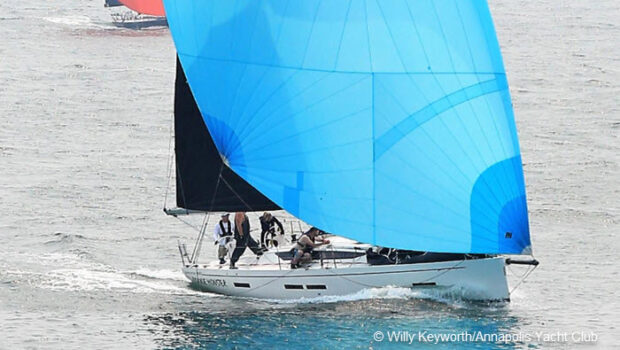


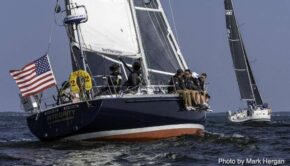
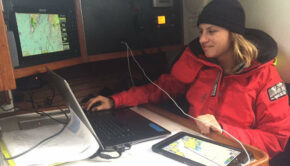
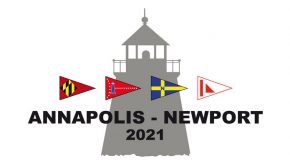
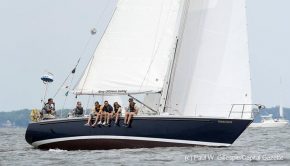
 We’ll keep your information safe.
We’ll keep your information safe.